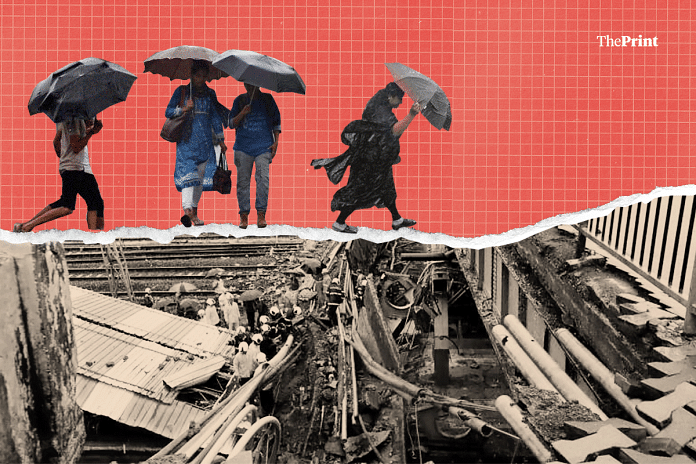Heavy showers hit Mumbai Tuesday, bringing the Maximum City to a virtual halt. In Andheri, a portion of a foot-overbridge caved in, leaving five people injured.
While the BMC promises better preparedness and infrastructure before every monsoon, Mumbaikars continue to face hardship.
ThePrint asks: Does Mumbai deserve its monsoon misery?
There is too much interference from various agencies
 Manisha Kayande
Manisha Kayande
Shiv Sena spokesperson
The Brihanmumbai Municipal Corporation (BMC) tries to do its best, but there are different challenges every time that complicate the situation. Today, for example, the collapse of the road overbridge at Andheri station added to people’s woes. When the quantity of rainfall is more than 80-100 mm in a day, the situation can get out of hand if even one thing goes wrong.
But having said that, it is not right to say that nothing is being done about it. Authorities take corrective measures immediately to provide relief to people. Today, for example, the Brihanmumbai Electricity Supply & Transport (BEST) undertaking started plying extra buses in the north-western suburbs to help people who were hit by the slow/no movement of trains on certain lines.
Over the years, the situation has improved. The BMC has deployed more people at chronic spots. The disaster management cell has become more efficient. Officials, engineers and employees are not allowed to take leaves on critical days. The disaster management cell issues timely advisories. People too are more alert now because of social media and avoid stepping out during heavy rain.
The people and the system too need to support the BMC a bit. Plastic is a reason why our drains get clogged, but when we try to implement a plastic ban, there are objections to it. People make it a political issue.
Also, in a place like Mumbai, there is too much interference from various agencies, which cannot be helped. For example, the Metro rail construction work this year has worsened the traffic and water-logging woes during the monsoon. Preventive measures can be taken but not much can be done about it because ultimately the city needs Metro too.
Carelessness, if any, will be exposed by the investigation
 Ravinder Bhakar
Ravinder Bhakar
PRO, Western Railway
Every year, we take extra precaution during monsoon. It not like we aren’t prepared but isolated incidents can happen. The Commission of Railway Safety (western circle) is looking into the matter. Whatever carelessness happened or whatever went wrong will be brought to the fore once the investigation is completed.
As far as the railways are concerned, our services run smoothly without much disruption even during heavy rain. Nearly 80 lakh people travel by trains in Mumbai, and there is one train running every three minutes.
As part of pre-monsoon preparation, we clean the major bulwarks, trim trees in the area, and carry out regular maintenance of all crucial implements.
Considering the extensive network and the number of people we ferry, we manage pretty well. We expect the public to be a little responsible as well so as to avoid a situation like last year’s stampede.
All agencies responsible for maintaining Mumbai’s infrastructure are on high alert. We even conduct inspections along with the BMC. We issue precautionary booklets with dates of high tides. This is done so that all agencies concerned are on high alert during those days.
Let’s also keep in mind that the recent incident concerns a road-overbridge. It doesn’t detract from the precautions we take on a regular basis.
Steps taken towards monsoon preparedness are showing results
 Ajoy Mehta
Ajoy Mehta
Municipal Commissioner, BMC
We did quite a few things differently this time, and the efforts are showing results.
After the 29 August flood last year, we identified 120 spots that were prone to water-logging. We examined the reasons for the flooding in these areas. This approach was different compared to previous years when the BMC mainly focused on the larger plans of cleaning and de-silting drains, among other things.
At one spot, tree roots were blocking the flow of water in the underground drainage system. At another point, cable wires were restricting the flow. We took corrective measures to fix these problems.
I won’t say there was no trouble, but water receded quickly at these places despite heavy rain.
At certain critical locations, we have installed some very powerful pumps to drain out water.
With construction on Metro railway lines underway at various places, we asked ward officers to jointly inspect the sites with Metro authorities. The BMC and Metro authorities attended to the issues following which we sent a second inspection team to ensure the work was done.
Railway tracks usually get flooded because water spills over the tracks when the culverts are not cleaned. Earlier, this was solely the railways’ responsibility. This time, we bought digital cameras and placed them below the culverts to monitor the situation. We gave photographs to railways with a list of pointers for action.
This has helped us immensely, especially with regard to tracks in low-lying areas such as Sion. While trains would earlier stop at Sion during heavy rain, today they were running on the stretch, although with a slight delay.
Plastic waste has been one of the biggest reasons for water-logging because it blocks our water laterals and chokes the grills of our pumping stations. This time, we have installed trash booms along the perimetre of all the rivers in the city so that the plastic gets blocked there itself.
After last year’s experience, we have started communicating weather advisories immediately to people.
Mumbai’s transport system is falling apart due to lack of coordination
 A.V. Shenoy
A.V. Shenoy
Transport expert, Mumbai Vikas Samiti
Railways are the backbone of Mumbai’s transport system. Heavy rain hits the movement of trains in the city. Those using app-based cab services are also affected due to surge pricing during monsoon.
The multiplicity of agencies and lack of coordination between them has hit Mumbai’s transport system. As a result, it is falling apart.
Mumbai is in no way dependent on rainwater. Lakes like Tansa, Bhatsa, Vaitarna provide Mumbai its drinking water. Whatever rainfall we get now eventually flows into the sea.
Earlier, we used to have stormwater drainage systems in Mumbai – 50 per cent of the rainwater would flow into the sea while the remaining would seep into the ground. Hence, Mumbai’s groundwater level was comparatively higher.
With more buildings coming up across the city, enough water does not percolate into the ground. The rainfall that we receive is thus useless because it does not even add to the groundwater level.
Mumbai tries to prep for monsoons, but never learns the big lessons
 Manasi Phadke
Manasi Phadke
Associate Editor, ThePrint
There is at least one day every year in the life of a Mumbai citizen when the city comes to a halt, streets are water-logged with chronic traffic bottlenecks, trains stop functioning and a journey that normally takes an hour can take nearly five.
Every year, the media, the people and the government authorities engage in the same debate – whether the civic body de-silted drains properly, why there was an indiscriminate dumping of plastic in our drains, whether there was coordination between the various agencies that work in Mumbai, and so on.
It shows our reluctance to learn the big lessons that perhaps make the city deserve its annual messy monsoon date.
Yes, Mumbai’s drainage capacity has improved, in theory, since the July 2005 inundation. The civic body has also deployed powerful de-watering pumps at low-lying areas, which are most prone to flooding. However, last year dozens of these pumps suffered technical glitches.
There are sharper and timely traffic and weather advisories. The civic body’s disaster management cell is stronger and more efficient with proper SOPs. Multiple agencies working in Mumbai are trying to coordinate their efforts towards monsoon-preparedness. But, a day of crisis still ends in a blame game.
But, a less than honest implementation of these small lessons can hardly help a sea-side megapolis with a population density of about 30,000 people per square kilometre that often records a rainfall of more than 100 mm in a short span of a day.
Civic and state authorities have made half-hearted efforts towards restoring degraded, polluted rivers. During monsoon, areas around these rivers often get flooded.
Suggestions on contour maps for a GIS-based flood modelling system and equipping at least major roads with drainage systems capable of tackling extra-ordinary floods have remained on paper.
Compiled by Manasi Phadke and Prerna Chatterjee






